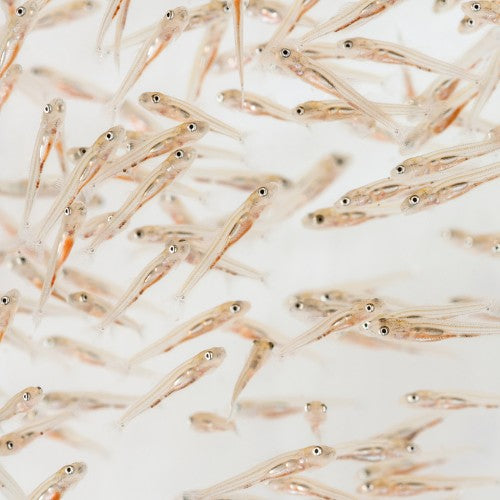
Well feeding fry from the first days
F. MattierShare
The fry of ovoviviparous fish (like the guppy) are already well developed at birth and generally survive easily.
But, in the case of oviparous fish, which are the vast majority of species, it is quite different.
Oviparous fish fry, when they hatch from the egg, are absolutely tiny. They are often referred to as "larvae," as they have very little in common with the adult.
This is why a female danio (zebra fish) can lay hundreds of eggs per day.
"Among the unfertilized eggs, those eaten by the parents or other fish, and the larvae that die in the first few days, it indeed takes hundreds of eggs to hope to have a few adults by the end."

However, if we eliminate the risk of predation by the parents, for example by removing them just after laying, the main difficulty is the food for these tiny, very fragile beings.
The very first days are dedicated to the hatching of the egg, then to the consumption of the yolk sac. Indeed, as soon as they hatch, the fry will settle somewhere and not move. Their nutritional needs are then met by this "sac," which contains all the necessary reserves.
After a few days (depending on the species and temperature), this pouch is empty, and the fry must urgently find something to eat. Without it, it dies very quickly, making this stage the critical phase par excellence.

The first food should match the size of its mouth, usually tiny.
It is also necessary that this food is alive, as the fry is instinctively attracted to movement.
"It is therefore necessary to be able to provide it with creatures that are around a hundred microns in size!"

These "infusoria," as they are called, are sometimes naturally present in the aquarium if it contains certain floating plants.
Indeed, the small roots of water lentils, three-lobed duckweeds, Salvinia, and even Azolla are teeming with infusoria. These microscopic animals find the bacteria they feed on there.
If the water level is low enough, the fry will have no trouble nesting among these plants and hunting whatever they find.
A much safer and more productive way is to use the famous "unprocessed paddy rice".
"Germination releases into the water many microscopic species from its original rice field that are trapped in the grain's husks. A few grains soaked to germinate a few days in advance will allow you to distribute thousands of infusoria to your babies."
You can also simply let a few grains float directly in the breeding tank, especially if they are kept on the surface by floating plants. The production of infusoria will then be much higher, more varied, and less random.
But there is also an easy-to-raise microscopic animal, barely longer but especially much thinner than most infusoria. It is the vinegar eel.
This almost invisible nematode rises in vinegar diluted with water.
It is a bit complicated to separate them from their environment (you shouldn't pour vinegar into an aquarium!). That’s why Aquazolla also offers "ready-to-use" doses: thousands of vinegar eels separated from the vinegar, in clean water. You just need to pour them into the breeding tank: these swimming worms will not be able to reproduce there, but will remain alive and mobile until your fry, attracted by their movement, eat them.
Here is a photo of a very young guppy fry that has spotted a water worm swimming in the water!

These first foods, easy to obtain, greatly increase the survival rate of your fry.
A fry must indeed "bathe" in food and have a full stomach at all times.
Then, after one to two weeks, you can feed them with micro worms, which are the easiest, most productive, and most efficient culture. Micro worms can also be given to guppy or platy fry as soon as they hatch.
"It is an almost magical food that allows to feed fry very early, and up to the juvenile stage. They will never turn away from it!"
The Zollabox Baby allows you to start this breeding, which requires no maintenance since it only needs to be replanted every month (there are also simple refills available).
The fry are then able to eat some daphnia. They will not eat the larger ones and will feed on those that they lay daily.
You will have thus raised your fry with a high success rate, and this without ever resorting to artemia nauplii, which are much heavier, more difficult, and more demanding to produce.
And above all, they do not survive long in freshwater if they are not quickly eaten.
A little paddy rice kept dry, a simple jar of vinegar where vinegar eels live in the cellar, and an easy and permanent culture of micro-worms.
With this, we are prepared all year round to face an unexpected happy event!



2 comments
Merci pour les infos pour nous les débutants
Je suis très satisfait et apprecier ce document